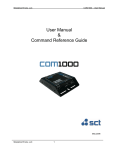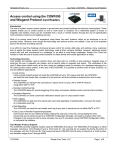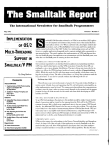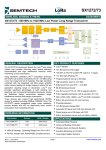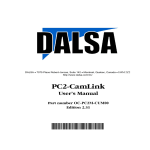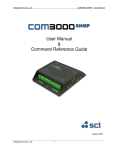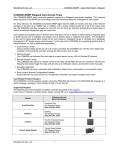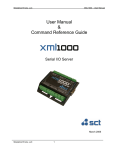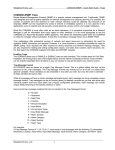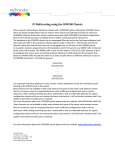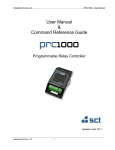Download SimpleComTools COM1000 Technical data
Transcript
SimpleComTools, LLC COM1000 – AT Commands COM1000 Setup and Configuration using AT Commands September 2004 SimpleComTools, LLC 1 SimpleComTools, LLC COM1000 – AT Commands Copyright © 2003 SimpleComTools, LLC All rights reserved. November 2003. The information in this document is subject to change without notice. The statements, configurations, technical data, and recommendations in this document are believed to be accurate and reliable, but are presented without express or implied warranty. Users must take full responsibility for their applications of any products specified in this document. The information in this document is proprietary to SimpleComTools, LLC. Trademarks SimpleComTools, the SimpleComTools logo, COM1000, and the COM1000 logo are trademarks of SimpleComTools, LLC. Statement of conditions In the interest of improving internal design, operational function, and/or reliability, SimpleComTools, LLC reserves the right to make changes to the products described in this document without notice. SimpleComTools, LLC does not assume any liability that may occur due to the use or application of the product(s) or circuit layout(s) described herein. USA requirements only Federal Communications Commission (FCC) Compliance Notice: Radio Frequency Notice This device complies with Part 15 of the FCC Rules. Operation is subject to the following two conditions: • This device may not cause harmful interference. • This device must accept any interference received, including interference that may cause undesired operation. Note: This equipment has been tested and found to comply with the limits for a Class B digital device, pursuant to Part 15 of the FCC Rules. These limits are designed to provide reasonable protection against harmful interference in a residential installation. This equipment generates, uses and can radiate radio frequency energy and, if not installed and used in accordance with the instructions, may cause harmful interference to radio communications. However, there is no guarantee that interference will not occur in a particular installation. If this equipment does cause harmful interference to radio or television reception, which can be determined by turning the equipment off and on, the user is encouraged to try to correct the interference by one or more of the following measures: • Reorient or relocate the receiving antenna. • Increase the separation between the equipment and receiver. • Connect the equipment into an outlet on a circuit different from that to which the receiver is connected. • Consult the dealer or an experienced radio/TV technician for help. European requirements only EN 55 022 statement This is to certify that the SimpleComTools COM1000 is shielded against the generation of radio interference in accordance with the application of Council Directive 89/336/EEC, Article 4a. Conformity is declared by the application of EN 55 022 Class B (CISPR 22). Canada requirements only Canadian Department of Communications Radio Interference Regulations This digital apparatus does not exceed the Class B limits for radio-noise emissions from digital apparatus as set out in the Radio Interference Regulations of the Canadian Department of Communications. Règlement sur le brouillage radioélectrique du ministère des Communications Cet appareil numérique respecte les limites de bruits radioélectriques visant les appareils numériques de classe B prescrites dans le Règlement sur le brouillage radioélectrique du ministère des Communications du Canada. SimpleComTools, LLC 2 SimpleComTools, LLC COM1000 – AT Commands Preface The COM1000 is part of the SimpleComTools Industrial Internet Appliance family. The COM1000 supports secure, reliable serial and IP communications and Internet Messaging applications in a single, integrated hardware device. In this guide, the COM1000 may also be referred to as ‘the device’. This guide provides instructions on how to install the COM1000, and how to install and replace other devices that may interface with the various inputs or interfaces available in the COM1000. This guide also includes technical specifications. Before you begin This guide is intended for qualified service personnel who are installing the COM1000 for the first time or who need to install a switch, gauge, modem, or other device to an existing COM1000. However, before you install anything related to the COM1000, make sure that the proper cables have been selected and/or the required network cabling has been installed using standard cable system practices. Acronyms This guide uses the following acronyms: CTS clear to send DCD data carrier detect DCE data communications equipment DSR data set ready DTE data terminal equipment DTR data terminal ready GND ground IP Internet Protocol LAN local area network LED light emitting diode MAC media access control NC normally closed NO normally open PPP point-to-point protocol PSTN public switched telephone network RTS ready to send RX receive data TX transmit data URL uniform resource locator VPN virtual private network WAN wide area network SimpleComTools, LLC 3 SimpleComTools, LLC COM1000 – AT Commands COM1000 Setup and Configuration using AT Commands To make setup and configuration easy, the COM1000 provides a common AT Command interface. This means the device is easily configured using any Telnet or Terminal application, such as HyperTerminal, Tera Term, or similar communications programs. This interface is also available via Telnet on TCP port 6123. Connection Steps Step 1: Connect your PC to the COM1000 Terminal Port using a standard RS232 serial cable. The COM1000 Terminal Port is a DCE port, so there is no need for a null adapter or crossover cable. A standard serial cable should work fine. Step 2: Open a connection using any Terminal program, such as HyperTerminal or Tera Term. The default setup for the Terminal Port is 115200, 8, None, and 1. NOTE: You may find it necessary to configure the Terminal Port of the COM1000 to meet certain parameters of your PC, such as a lower baud rate, or different parity, etc. If so, please refer to the RS232/Terminal Port section of the attached Command Appendix. You must also press the RESET button on the COM1000 in order for any serial port changes to take effect. Step 3: Once connected, hit the ENTER key. You should see the COM1000 respond with a command prompt that looks like the one shown here. If the COM1000 does not respond with a command prompt, it is likely in Protected Mode, which means you will need a password to gain access. (Refer to SECURITY section for more details) Step 4: Once you have successfully gained access to the command prompt, you can view or edit any of the COM1000 application registers. To view ALL the current register settings, use the AT command AT&V. To see just a portion of the registers, type AT&V followed by the number of the portion you wish to view. Example: to view the GENERAL section, type AT&V 1. The AT Command for each parameter is described in detail in a later section. SimpleComTools, LLC 4 SimpleComTools, LLC COM1000 – AT Commands SECURITY To make the COM1000 secure from unauthorized users, you can set it to run in the PROTECTED MODE. This is an option that must be activated by the user. The following are the steps to enabling this feature. Step 1: Set the device Password BEFORE activating PROTECTED MODE, it is necessary to select a device password. This will be the secret password used at the serial or Telnet command prompt. The factory default password is ‘SIMPLE’ (uppercase). To set the new device password, enter the command AT*PASSWORD=xxxxxx, where ‘xxxxxx’ is any alphanumeric character stream up to 20 characters. Step 2: Activate PROTECTED MODE Now that you have a known password, you can set the device to operate in PROTECTED MODE. This means that users will need to know the device password to get past the command line prompt. To activate/enable PROTECTED MODE, type the command AT*PROTECT=1 at the prompt. The screen will display a ‘1’ and an ‘OK’ to show that the command was accepted. The ‘>’ symbol will now be shown as the as the prompt. Pressing the ENTER key will result in a password challenge. To access the device, enter the dev ice password (xxxxxx from above). New Password Generation PROTECTED MODE Activation SimpleComTools, LLC 5 SimpleComTools, LLC COM1000 – AT Commands Other Security Features Inactivity Lockout: After 15 minutes of inactivity (no keystrokes), the COM1000 will drop back into PROTECTED MODE, and you will need to re-enter the device password to gain access to the device. Inactivity Lockout Password Recovery: In the event the password for a COM1000 is lost or unrecoverable, SimpleComTools can provide a unique 24-hour access password. This is a unique password generated by SCT based upon a primer provided by the COM1000 at the command prompt. To activate this primer, simply enter a ‘?’ at the command prompt. See the example below… At the password: prompt, enter a ‘?’ and you will see the response “Contact SimpleComTools with the following for a 24 hour password:” followed by the unique password PRIMER. This PRIMER is a one-time value that expires after 24 hours. Passwords generated based on this value will only work within that period as well. SimpleComTools, LLC 6 SimpleComTools, LLC COM1000 – AT Commands AT Command Usage The COM1000 provides (4) types of Commands: • AT : These are traditional Hayes-Compatible AT Commands • AT& : These are traditional Hayes-Compatible AT Commands • AT* : These are COM1000 specific AT Commands • Non AT Commands : These are commands that do not use the ‘AT’ prefix The following is a list of the AT Commands in alphabetical order. For more specifics on how to apply these commands, please consult the COM1000 User Manual. AT Command Description E Echo typed characters back locally Q Terminal Port Quiet Mode Z Resets the device. Stops all operations. Does NOT delete values stored in NVRAM. \Q Terminal Port Flow Control &C Terminal Port DCD Control &D Terminal Port DTR Control &F Returns OK No valid operation. All register settings remain the same. &S Terminal Port DSR Control Displays all registers. AT&V followed by a space and integer will display a single group of values. Integers correspond to the Configuration Utility tabs. &V 5 – RS485 Port 6 – DNS/DDNS 7 – Messaging 8 – FTP Client 1 – General 2 – Clock 3 – Modem Port 4 – Terminal Port 9 – Instant Messaging 10 - Scheduler 11 – Analog Input 12 – Digital Input 13 – Digital Input 2 14 – Digital Input 3 15 – Digital Input 4 16 – Relay Examples: “AT&V 8” returns all FTP Client settings &W SimpleComTools, LLC Returns OK when changes are successfully written to registers. 7 SimpleComTools, LLC * I1TCPDESTIP * I1TCPDESTPORT * I1UDPDESTIP * I1UDPDESTPORT COM1000 – AT Commands IP or Domain of TCP Packet Destination x.x.x.x or abc.123.com (Up to 50 characters) TCP Packet Destination Port = nnnnn (5 digit value with range between 1 and 65535) IP or Domain of UDP Packet Destination x.x.x.x or abc.123.com (Up to 50 characters) UDP Packet Destination Port = nnnnnn (5 digit value with range between 1 and 65535) *485APP1 RS485 Application #1; *485APP2 RS485 Application #2; *485APP3 RS485 Application #3; *485BAUD Sets RS485 Port Baud Rate Syntax = <baud rate> Example: 19200DEFAULT = 9600 *485BUFFER RS485 Port Application Buffer Size: (n = 0 - 256 KBytes). Amount of data to be stored before executing any of the *485APP selections. This value requires that one of the RS485 PORT APP triggers be set to 4 (Buffer).Note: The buffer size is shared between the TERMINAL and RS485 PORTS for a total of 256 KBytes. The amount available to one port will depend on the usage of the other. *485E *485ESC *485EVENTMSG *485H *485ICT *485Q SimpleComTools, LLC Echo typed characters back locally Sets Terminal Escape String: Alphanumeric value up to 20 characters Customizable RS485 event message text. (Up to 20 characters) A free-text field used when applications are set to 3 or 4 (SMTP or SMS). This text will be seen as the message SUBJECT field. Sets Terminal Hangup String: Alphanumeric value up to 20 characters RS485 Inter-Character Timer. (n = 100 - 65535 milliseconds)The length of time between characters that is necessary to consider the data stream ended. This value requires that one of the RS485 PORT APP triggers be set to 2 (Intercharacter Timer.). Quiet Mode: 8 SimpleComTools, LLC *485RECIPIENT COM1000 – AT Commands n, n, n, n … = Desired message recipient(s) as detailed in Message Config registers. (Comma separation for multiple, ie 1,2,3,4,5,6,7,8) Max number = 8. *485STREAM1 Serial Data Stream used to trigger events (Up to 20 characters) *485STREAM2 Serial Data Stream used to trigger events (Up to 20 characters) *485STREAM3 Serial Data Stream used to trigger events (Up to 20 characters) *485TCPDESTIP *485TCPDESTPORT IP or Domain of TCP Packet Destination x.x.x.x or abc.123.com (Up to 50 characters) TCP Packet Destination Port = nnnnnn (5 digit value with range between 1 and 65535) *485TCPIATIMER TCP inactivity timer. Device will drop TCP connection if there is no data flow for that period of time. (n =0-255 Seconds) *485TCPRETRIES The number of TCP Retries. Number of times to retry making a connection to the TTCPDESTIP remote IP address after a failed connection attempt. *485TCPSERVER TCP/Device Server Application: *485TCPSESSTIME TCP Session connection timer. TCP Client will drop TCP connection after the stated period of time. (n =0-255 Seconds) *485TCPSVRPORT TCP/Device Server Application Port. = nnnnnn (5 digit value with range between 1 and 65535) *485TCPSVRTIMER TCP/Device Server inactivity timer. Device Server will drop TCP connection if there is no data flow for that period of time. (n =0-255 Seconds) *485TIMER1 Timer: (n = # Minutes) *485TIMER2 Timer: (n = # Minutes) *485TIMER3 Timer: (n = # Minutes) *485TRIG1 RS485 Application #1 Trigger; *485TRIG2 RS485 Application #2 Trigger; SimpleComTools, LLC 9 SimpleComTools, LLC *485TRIG3 *485UDPDESTIP *485UDPDESTPORT *485UDPSERVER *AALARMREPT COM1000 – AT Commands RS485 Application #3 Trigger; IP or Domain of UDP Packet Destination. x.x.x.x or abc.123.com (Up to 50 characters) UDP Packet Destination Port = nnnnnn (5 digit value with range between 1 and 65535) UDP/Device Server Application Desired message recipient(s) as detailed in Messaging Config registers. =[n, n, n, n … ](Comma separation for multiple, ie 1,2,3,4,5,6,7,8) Max number = 8. *ACALIBRATE Calibrates the COM1000 to match the actual current sensor reading. If you know the ACTUAL value being measured, you would enter that real value. The COM1000 will take its current reading, and perform a calculation to come up with the offset so as to give you a more accurate reading going forward. *ACTMSGFREQ Repeat Active Event Message Transmission Frequency; Frequency of Repeating Active Event Messages. This value controls the behavior when a Digital Input state or Analog Input value has not changed, and a repeat message is about to be sent. Default is every 30 Minutes *AHIGHALARM Displays High Alarm Count. *AHIGHALARMACT Sets the High Alarm Action. *AHIGHALARMMSG Customized High Alarm Set Point Message. (Up to 20 characters) A free-text field used in all UDP, TCP, SMS, and SMTP messages. For SMS and SMTP, this will be seen as the SUBJECT field. *AHIGHALARMSET High Alarm Set Point Set Point for exception reporting (n = 0.0-30.0) *AHIGHWARN Displays High Warning Count. *AHIGHWARNACT Sets the High Warning Action. *AHIGHWARNMSG Customized High Warning Set Point Message. (Up to 20 characters) A free-text field used in all UDP, TCP, SMS, and SMTP messages. For SMS and SMTP, this will be seen as the SUBJECT field. *AHIGHWARNSET High Warning Set Point. The Set Point for exception reporting (n = 0.0-30.0) SimpleComTools, LLC 10 SimpleComTools, LLC COM1000 – AT Commands *ALOWALARM Displays Low Alarm Count. *ALOWALARMACT Sets the Low Alarm Action. *ALOWALARMMSG Customized Low Alarm Set Point Message. (Up to 20 characters) A free-text field used in all UDP, TCP, SMS, and SMTP messages. For SMS and SMTP, this will be seen as the SUBJECT field. *ALOWALARMSET Low Alarm Set Point. The Set Point for exception reporting (n = 0.0-30.0) *ALOWWARN Displays Low Warning Count. *ALOWWARNACT Sets the Low Warning Action. *ALOWWARNMSG Customized Low Warning Set Point Message. (Up to 20 characters) A free-text field used in all UDP, TCP, SMS, and SMTP messages. For SMS and SMTP, this will be seen as the SUBJECT field. *ALOWWARNSET Low Warning Set Point. The Set Point for exception reporting (n = 0.0-30.0) *ANALOG *ANALOGEXT *ANAME Returns current reading of analog input Free text extension appended to the analog value output. Customized ANALOG Interface Name. A free-text field for the NAME of the interface which will be used in all UDP, TCP, and SMTP alerts. For SMTP alerts, this will be seen as the FROM field. (Up to 20 characters) *ARANGEMAX Highest range value of the chosen sensor. *ARANGEMIN Lowest range value of the chosen sensor. *ATCPDESTIP IP or Domain of TCP Packet Destination. x.x.x.x or abc.123.com (Up to 50 characters) *ATCPDESTPORT *AUDPDESTIP SimpleComTools, LLC TCP Packet Destination Port = nnnnnn (5 digit value with range between 1 and 65535) IP or Domain of UDP Packet Destination. x.x.x.x or abc.123.com (Up to 50 characters) 11 SimpleComTools, LLC *AUDPDESTPORT COM1000 – AT Commands UDP Packet Destination Port = nnnnnn (5 digit value with range between 1 and 65535) *AVALRESET Reset COUNTER value after reporting *AVOLTMAX Highest voltage output of the chosen sensor. *AVOLTMIN Lowest voltage output of the chosen sensor. *AWARNRECPT Desired message recipient(s) as detailed in Messaging Config registers. =[n, n, n, n … ](Comma separation for multiple, ie 1,2,3,4,5,6,7,8) Max number = 8. *CLEARCOUNTS Sets all the Digital Inputs back to ‘0’. *CLEAREVENTS Erases the COM1000 EVENT log. New log will begin immediately. *CLEARLOG Erases the COM1000 performance log buffer. New log will begin immediately. *DATE Set DATE: MM/DD/YYYY *DDNS Forces DDNS update to DDNS server *DDNSIP IP or Domain Name of Dynamic Domain Name System (DNS) Server. Accepts n.n.n.n or abc.123.com (Up to 50 characters) *DDNSPASS DDNS Account Password; *DDNSPORT DDNS Server Port = nnnnnn (5 digit value with range between 1 and 65535) (Default is 53) *DDNSTIMER Sets the update interval update interval for timed updates to DDNS server Options: 0 = not active (DEFAULT) 1-65535 = number of minutes between updates *DDNSTYPE Dynamic DNS Server Protocol or Service. Options: 0 = DDNS Not Used 1 = DTDNS.COM 2 = SITESOLUTIONS.COM 3 = DYNDNS.ORG-DYNAMIC 4 = DYNDNS.ORG-CUSTOM 5 = DYNDNS.ORG-STATIC SimpleComTools, LLC 12 SimpleComTools, LLC COM1000 – AT Commands *DDNSUSER Primary DDNS Account Username; *DELIMITER Device stored data default output delimiter: *DHCP Dynamic Host Configuration Protocol (DHCP) is used for assigning dynamic IP addresses to devices on a network. DHCP being on by default allows for the COM1000 to be added to a network without manually assigning a unique IP address. Leaving DHCP on means the unit will get a different IP address every time it connects to the network. *DNS1 x.x.x.x = IP of Primary Domain Name Server 0.0.0.0 = DNS Supplied by PPP or DHCP *DNS2 x.x.x.x = IP of Secondary Domain Name Server 0.0.0.0 = DNS Supplied by PPP or DHCP *DOMAIN *DST *FACTORY *FTPDIR *FTPFILENAME *FTPIP Device DOMAIN (domain.com): Names consists of a sequence of two or more groups of characters separated by periods; and include the first-level domain name (or top-level domain name), along with second or third level names. Example: the host “computer.mydomain.com" would belong to the Domain “mydomain.com”. Accepts alphanumeric values up to 50 characters. Acceptable characters include A-Z, 0-9, and – or _. Characters ~ ! @ # $ % ^ & *,.; are invalid. Daylight savings time enabled: Resets all register values to factory default. Initial Remote Host Directory FTP Remote File Name Syntax; x.x.x.x or abc.123.com = IP or Domain of FTP Server (Up to 50 characters) *FTPMODE By default, FTP data connections are established by the FTP server. Passive Mode forces the data connections to be established by the client. Passive mode may be required for users who are behind some types of router-based firewalls or behind a gateway requiring passive transfers. *FTPPASS Primary FTP Server Account Password; *FTPPORT FTP Server Port (Default is 21) = nnnnnn (5 digit value with range between 1 and 65535) SimpleComTools, LLC 13 SimpleComTools, LLC COM1000 – AT Commands *FTPUSER Primary FTP Server Account Username; *GATEWAY x.x.x.x = IP address of the router or computer that routes the traffic from the COM1000 to another outside network such as the Internet. Consult your Network Administrator for the appropriate GATEWAY value. *GSMS *GETEVENTS *GETLOG *HOSTNAME *I1 *I1ACTIVEACTION ‘GET SMS MESSAGES’ (Forces COM1000 to initiate a check of the SMS Modem/Radio to see if there are any new SMS Messages) Returns content of the Event Log. Will return either COUNTS and/or EVENT log depending on configuration of interfaces and SCHEDULER. Returns contents of the COM100 performance log. Includes system startup, network connections, system errors, input state changes, etc. Device HOSTNAME: Name to be used for domain name and as NETBIOS name for Windows Networks Example: the hostname “computer “ would be known as “computer” on the local Windows LAN and “computer.mydomain.com” over the internet. *HOSTNAME accepts alphanumeric values up to 50 characters. Acceptable characters include A-Z, 0-9, and – or _. Characters ~ ! @ # $ % ^ & *,.; are invalid. Current Digital Input 1 Status; (Query ONLY) Digital Input 1 ACTIVE EVENT action. This is the event that will be triggered when the switch connected to the digital input changes to the ACTIVE state. *I1ACTIVEMSG Customized Digital Input 1 Active State message. (Up to 20 characters) A freetext field used when the switch is in the ACTIVE state. Text is used in all Serial, UDP, TCP, SMS, and SMTP messages. For SMS and SMTP, this will be seen as the SUBJECT field. *I1ACTIVENAME Customized Digital Input 1 Active State name. (Up to 20 characters) A free-text field used when the switch is in the ACTIVE state. Name will be used in all UDP, TCP, SMS, and SMTP messages. For SMS and SMTP, this will be seen as the SUBJECT field. *I1COUNT *I1INACTIVEACTION *I1INACTIVEMSG SimpleComTools, LLC Reports current count of Digital Input 1 (Query ONLY) Digital Input 1 INACTIVE EVENT action. This is the event that will be triggered when the switch connected to the digital input changes to the INACTIVE state. Customized Digital Input 1 Inactive State message. (Up to 20 characters) A free-text field used when the switch is in the INACTIVE state. Text is used in all Serial, UDP, TCP, SMS, and SMTP messages. For SMS and SMTP, this will be seen as the SUBJECT field. 14 SimpleComTools, LLC *I1INACTIVENAME *I1NAME *I1RECIPIENT *I1SWITCHTYPE *I1VALRESET COM1000 – AT Commands Customized Digital Input 1 Inactive State name. (Up to 20 characters) A freetext field used when the switch is in the INACTIVE state. Name will be used in all UDP, TCP, SMS, and SMTP messages. For SMS and SMTP, this will be seen as the SUBJECT field. Customized Digital Input 1 interface NAME. (Up to 20 characters) A free-text field for the NAME of the interface which will be used in all UDP, TCP, and SMTP alerts. For SMTP alerts, this will be seen as the FROM field. Desired message recipient(s) as detailed in Message Config registers. =[n, n, n, n … ](Comma separation for multiple, ie 1,2,3,4,5,6,7,8) Max number = 8. Digital Input 1 Switch Type Reset COUNTER value after reporting *IMBUDDY1 IM Buddy Nickname; *IMBUDDY2 IM Buddy Nickname; *IMBUDDY3 IM Buddy Nickname; *IMBUDDY4 IM Buddy Nickname; *IMBUDDY5 IM Buddy Nickname; *IMBUDDY6 IM Buddy Nickname; *IMBUDDY7 IM Buddy Nickname; *IMBUDDY8 IM Buddy Nickname; *IMMODE Instant Message Protocol Mode; *IMNICK IM Account Nickname; *IMPASS IM Account Password; SimpleComTools, LLC 15 SimpleComTools, LLC *IMSERVERIP *IMSERVERPORT *IMUSER *INACTMSGFREQ COM1000 – AT Commands IP or Domain of Instant Message Server. x.x.x.x or abc.123.com (Up to 50 characters) Instant message Server Port = nnnnnn (5 digit value with range between 1 and 65535) IM Account Username; Repeat Inactive Event Message Transmission Frequency; Frequency of Repeating Inactive Event Messages. This value controls the behavior when a Digital Input state or Analog Input value has not changed, and a repeat message is about to be sent. Default is every 30 Minutes *M\Q Flow Control: *MC DCD Control: *MD DTR Control: *MDIAL *ME Sets Modem Dial String: Alphanumeric value up to 20 characters Echo typed characters back locally *MESC Sets Modem Escape String: Alphanumeric value up to 20 characters *MH Sets Modem Hangup String: Alphanumeric value up to 20 characters *MINIT Sets Modem Initialization String: Alphanumeric value up to 20 characters *MMODE Modem Mode of Operation *MMODETIMER Modem Connection Timer *MPORT *MSGMETHOD SimpleComTools, LLC Sets Modem Port Baud Rate, Data Bits, Parity and Stop Bits. Syntax = <baud rate>,<data bits><parity><stop bits> Example: 19200,8N1DEFAULT = 115200,8N1 Outbound Message Notification Method; 16 SimpleComTools, LLC COM1000 – AT Commands *MPASSWORD AT*MPASSWORD=xxxxxx Sets the dialup or PPP Password, where 'xxxxxx' is any alphanumeric character stream up to 20 characters. Acceptable characters include A-Z, 0-9, and - or _. Characters ~ ! @ # $ % ^ & *,.; are invalid. *MUSER AT*MUSER=xxxxxx Sets the dialup or PPP Uername, where 'xxxxxx' is any alphanumeric character stream up to 20 characters. Acceptable characters include A-Z, 0-9, and - or _. Characters ~ ! @ # $ % ^ & *,.; are invalid. *NETMASK x.x.x.x = IP address subnet mask used to determine what subnet an IP address belongs. Examples include: 255.255.255.0; 255.255.240.0; 255.255.0.0, etc. Consult your Network Administrator for the appropriate SUBNET MASK value. *PASSWORD AT*PASSWORD=xxxxxx Sets the device Password, where 'xxxxxx' is any alphanumeric character stream up to 20 characters. Acceptable characters include A-Z, 0-9, and - or _. Characters ~ ! @ # $ % ^ & *,.; are invalid. This will be the secret password used at the serial or Telnet command prompt. Factory default password is 'SIMPLE' (uppercase). *PKTFORMAT Select a packet format for UDP/TCP application messages. Options: 0 = Data Only (DEFAULT) 1 = Message Only 2 = HostName, Data 3 = Date/Time, Data 4 = HostName, Date/Time, Data 5 = HostName, Date/Time, Message, Data 6 = Use Status 7 = Raw Data *PINGIP *PINGRETRIES x.x.x.x or abc.123.com IP or Domain of remote destination where the device will PING to ensure a PPP connection is still active. (Up to 50 characters) Number of times to PING the remote destination IP or Domain during a PING event. This number should be tuned to guarantee at least one PING success during an event. (5 digit value with range between 0 and 65535) Number of minutes to wait before the next PING attempt. *PINGTIMER *PROTECT Options: 0 = PING if Off (DEFAULT) 1-65535 = Number of Minutes to wait before next attempt Enable/Disable PROTECTED mode. Protected Mode restricts access to the device. Options: 0 = Disabled (DEFAULT) 1 = Enabled NOTE: When Protected Mode is enabled, the '>' symbol will now be shown as the as command the prompt. Pressing the ENTER key will result in a password challenge. To access the device, enter the device password. *RELAY SimpleComTools, LLC Displays current state of RELAY. Command followed by =n will execute that value. 17 SimpleComTools, LLC COM1000 – AT Commands *RNAME Customized RELAY Interface Name. A free-text field for the NAME of the interface which will be used in all UDP, TCP, SMS, and SMTP messages. (Up to 20 characters) *ROFFALIAS Customizable Relay ON command. This is a free-text field to be used to create a term to be interpreted as the *ROFF AT Command. (Accepts up to 20 characters)Example: 'AT*ROFFALIAS=engine-off' would allow for the term 'engine-off' to be used as a command to DE-ENERGIZE the relay. *ROFFAUTO Relay Auto-Off Timer; Interval of timer the relay will stay energized after being turned on. *ROFFMSG Customized Relay De-energized State message. (Up to 20 characters) A freetext field used when the Relay is in the active state. Text is used in all UDP, TCP, SMS, and SMTP messages. For SMS and SMTP, this will be seen as the SUBJECT field. *RONALIAS Customizable Relay ON command. This is a free-text field to be used to create a term to be interpreted as the *RON AT Command. (Accepts up to 20 characters)Example: 'AT*RONALIAS=engine-off' would allow for the term 'engine-off' to be used as a command to ENERGIZE the relay. *RONMSG Customized Relay Energized State message. (Up to 20 characters) A free-text field used when the Relay is in the active state. Text is used in all UDP, TCP, SMS, and SMTP messages. For SMS and SMTP, this will be seen as the SUBJECT field. *RRECIPIENT *RSCHDOM Desired message recipient(s) as detailed in Message Config registers. Comma separation for multiple, (ie 1,2,3,4,5,6,7,8). Max number = 8. Sets the DAY OF MONTH for regularly scheduled relay triggering. Set this value if you do NOT want the relay to be triggered every day. Otherwise, the default value of 0 will ensure this happens daily. Options: 0 = Every Day (DEFAULT) st nd 1-31 = Day of the Month. (1=1 day, 2=2 day, etc) Note: Triggering once-per-month requires that DAY OF WEEK be set to ‘0’. *RSCHDOW Sets the DAY OF WEEK for regularly scheduled relay triggering. Only set this value if you do NOT want the relay to be triggered every day. Otherwise, the default value of 0 will ensure this happens daily. Options: 0 = Every Day (DEFAULT) 1-7 = Day of the Week starting with Sunday. (Sun=1, Mon=2, etc) Note: Requires the value DAY OF WEEK or DAY OF MONTH be set as well. *RSCHTIMER SimpleComTools, LLC Sets the time interval for recurring relay triggering to take place within the same 24-hour period. This requires that the value *ROFFAUTO also be set, or else the relay will stay on after the first trigger. Options: 0 = no timer active (DEFAULT) 1-1440 = number of minutes between relay triggers 18 SimpleComTools, LLC *RSCHTOD COM1000 – AT Commands Sets the TIME OF DAY for regularly scheduled relay triggering. Set the time value using the format HH:MM. Must enter value in Military time. Example = 16:00 (aka: 4PM). Options: 00:00 = Midnight (DEFAULT) Note: Requires the value DAY OF WEEK or DAY OF MONTH be set as well. *RTC *RTCTIME *RTCIP Forces real-time clock update from SNTP server specified in the *RTCIP. Real-time Clock Timer. Update interval for timed updates from SNTP server specified in the *RTCIP. IP or Domain of Simple Network Time Protocol (SNTP) server. x.x.x.x or abc.123.com (Up to 50 characters) Real Time Clock Zone. Time zone where the device will be located. Enter integer value between -12 and +13 to indicate the offset from Greenwich Mean Time (GMT). Values are as follows: *RTCZONE *SCHEDDOM -12:00 = GMT-12 – Eniwetok -11:00 = GMT-11 – Samoa -10:00 = GMT-10 – Hawaii -09:00 = GMT- 9 – Alaska -08:00 = GMT- 8 – US Pacific Time -07:00 = GMT- 7 – US Mountain Time -06:00 = GMT- 6 – US Central Time -05:00 = GMT- 5 – US Eastern Time -04:00 = GMT- 4 – Atlantic Time -03:00 = GMT- 3 – Greenland -02:00 = GMT- 2 – Mid-Atlantic -01:00 = GMT- 1 – Azores 00:00 = GMT- 0 – Greenwich Mean Time +01:00 = GMT+ 1 – Berlin, Rome, Paris +02:00 = GMT+ 2 – Jerusalem, Helsinki +03:00 = GMT+ 3 – Moscow, Nairobi +04:00 = GMT+ 4 – Abu Dhabi +05:00 = GMT+ 5 – Karachi +06:00 = GMT+ 6 – Astana +07:00 = GMT+ 7 – Bangkok +08:00 = GMT+ 8 – Hong Kong, Singapore +09:00 = GMT+ 9 – Tokyo +10:00 = GMT+10 – Guam +11:00 = GMT+11 – New Caledonia +12:00 = GMT+12 – Fiji +13:00 = GMT+13 – Nuku’alofa Sets the DAY OF MONTH for regularly scheduled EVENT logging. Set this value if you do NOT want the log to be appended every day. Otherwise, the default value of 0 will ensure that event data is added to the log daily. Options: 0 = Every Day (DEFAULT) st nd 1-31 = Day of the Month. (1=1 day, 2=2 day, etc) Note: Triggering once-per-month requires that DAY OF WEEK be set to ‘0’. *SCHEDDOW Sets the DAY OF WEEK for regularly scheduled EVENT logging. Set this value if you want the log to be appended every day. Otherwise, the default value of 0 will ensure that event data is added to the log daily. Options: 0 = Every Day (DEFAULT) 1-7 = Day of the Week starting with Sunday. (Sun=1, Mon=2, Tue=3, etc) Note: Requires that the value DAY OF WEEK or DAY OF MONTH be set as well. AT*SCHFTPTIME SimpleComTools, LLC SCHEDULED FTP TIMER Time interval for scheduled FTP upload of data files. Time value is in minutes. Options: 0 = not active (DEFAULT) 1-65535 = number of minutes (65535 min = ~45 days) 19 SimpleComTools, LLC AT*SCHFTPTYPE *SCHMSGTIME *SCHMSGRECIPIENT *SCHEDTIMER COM1000 – AT Commands SCHEDULED FTP TYPE Data format to be uploaded by FTP client. Data will be sent in TXT file format. Options: 0 = None (DEFAULT) 1 = Status (The STATUS events specified in the General Tab) 2 = Log (The device EVENT LOG will be uploaded) SCHEDULED MESSAGE TIMER. Sets the time interval for scheduled sending of data files via SMTP or SMS. Value is in minutes. Options: 0 = not active (DEFAULT) 1-65535 = number of minutes (65535 min = ~45 days) SCHEDULED MESSAGE RECIPIENTS Scheduled message recipient(s) for SMTP or SMS messages. Recipient details are specified in the MESSAGING tab. Max number of recipients = 8. (Comma separation for multiple recipients - ie; 1,2,3,4,5,6,7,8) Sets the time interval for recurring logging to take place within the same 24-hour period. Options: 0 = no logging (DEFAULT) 1-1440 = number of minutes between log entries Sets the TIME OF DAY for regularly scheduled logging. Set the time value using the *SCHEDTOD format HH:MM. Must enter value in Military time. Example = 16:00 (aka: 4PM). Options: 00:00 = Midnight (DEFAULT) Note: Requires that the value DAY OF WEEK or DAY OF MONTH be set as well. *SCHEDTYPE Sets the TYPE of log entries being created. Options: 0 = COUNT INPUT EVENTS (DEFAULT) 1 = LOG INPUT EVENT DETAILS *SENDTO1 50 character alphanumeric value; can be phone number or email address *SENDTO2 50 character alphanumeric value; can be phone number or email address *SENDTO3 50 character alphanumeric value; can be phone number or email address *SENDTO4 50 character alphanumeric value; can be phone number or email address *SENDTO5 50 character alphanumeric value; can be phone number or email address *SENDTO6 50 character alphanumeric value; can be phone number or email address *SENDTO7 50 character alphanumeric value; can be phone number or email address SimpleComTools, LLC 20 SimpleComTools, LLC *SENDTO8 *SMSGETTIME COM1000 – AT Commands 50 character alphanumeric value; can be phone number or email address SMS GET MESSAGE TIMER Frequency on which to check for SMS Messages *SMSMODEM SMS Modem Type;0 = No SMS Service Used1 = AirLink Redwing CDMA2 = AirLink Redwing GPRS3 = AnyData iPort4 = Nokia GSM5 = Siemens M206 = Wavecom Fastrack *SMTPAUTH SMTP Server Uses Authentication; *SMTPEMAIL EMAIL for SMTP Authentication: *SMTPIP IP or Domain of SMTP Server. x.x.x.x or abc.123.com (Up to 50 characters) *SMTPPASS SMTP Account Password; *SMTPPORT SMTP Server Port = nnnnnn (5 digit value with range between 1 and 65535) (Default is 25) *SMTPUSER SMTP Account Username; *STATICIP *STATUS x.x.x.x = Static IP address to be assigned to the Ethernet interface. This is the address to be used every time the device is powered up. Only takes effect if the value *DHCP=0.Consult your Network Administrator for the appropriate IP Address. Configures interface values to be displayed by the 'STATUS' command. This includes Analog Input, Digital Inputs, Relay State, and Modem status. Multiple values are separated by commas. (Example AT*STATUS=1,2,3,4,5,6,7,8,9) *TAPP1 Terminal Port Application #1; *TAPP2 Terminal Port Application #2; *TAPP3 Terminal Port Application #3; *TBUFFER SimpleComTools, LLC Terminal Port Application Buffer Size: (n = 0- 256 KBytes). Amount of data to be stored before executing any of the *TAPP selections. This value requires that one of the TERMINAL PORT APP triggers be set to 4 (Buffer).Note: The buffer size is shared between the TERMINAL and RS485 PORTS for a total of 256 KBytes. The amount available to one port will depend on the usage of the other. 21 SimpleComTools, LLC *TESC *TEVENTMSG *TH COM1000 – AT Commands Sets Terminal Escape String: Alphanumeric value up to 20 characters Customizable Terminal Port message text. (Up to 20 characters) A free-text field used when Terminal Port Applications are set to 3 or 4 (SMTP or SMS). This text will be seen as the message SUBJECT field. Sets Terminal Hangup String: Alphanumeric value up to 20 characters *TICT Terminal Port Inter-Character Timer. (n = 100 - 65535 milliseconds)The length of time between characters that is necessary to consider the data stream ended. This value requires that one of the TERMINAL PORT APP triggers be set to 2 (Inter-character Timer.). *TIME Set TIME: HH:MM:SS. Must express value in Military time (24Hour Clock) *TPORT Sets Terminal Port Baud Rate, Data Bits, Parity and Stop Bits. Syntax = <baud rate>,<data bits><parity><stop bits> Example: 19200,8N1DEFAULT = 115200,8N1 *TRECIPIENT n, n, n, n … = Desired message recipient(s) as detailed in Message Config registers. (Comma separation for multiple, ie 1,2,3,4,5,6,7,8) Max number = 8. *TSTREAM1 Serial Data Stream used to trigger events (Up to 20 characters).This value requires that TERMINAL PORT APP #1 TRIGGER be set to 3 (Stream). *TSTREAM2 Serial Data Stream used to trigger events (Up to 20 characters).This value requires that TERMINAL PORT APP #2 TRIGGER be set to 3 (Stream). *TSTREAM3 Serial Data Stream used to trigger events (Up to 20 characters).This value requires that TERMINAL PORT APP #3 TRIGGER be set to 3 (Stream). *TTCPDESTIP IP or Domain of TCP Packet Destination. x.x.x.x or abc.123.com (Up to 50 characters) *TTCPDESTPORT TCP Packet Destination Port = nnnnnn (5 digit value with range between 1 and 65535) *TTCPIATIMER TCP inactivity timer. Device will drop TCP connection if there is no data flow for that period of time. (n =0-255 Seconds) *TTCPRETRIES The number of TCP Retries. Number of times to retry making a connection to the TTCPDESTIP remote IP address after a failed connection attempt. *TTCPSERVER TCP/Device Server Application: *TTCPSESSTIME SimpleComTools, LLC TCP Session connection timer. TCP Client will drop TCP connection after the stated period of time. (n =0-255 Seconds) 22 SimpleComTools, LLC COM1000 – AT Commands *TTCPSVRPORT TCP/Device Server Application Port = nnnnnn (5 digit value with range between 1 and 65535) *TTCPSVRTIMER TCP/Device Server inactivity timer. Device Server will drop TCP connection if there is no data flow for that period of time. (n =0-255 Seconds) *TTIMER1 Terminal Port Application #1 Timer Trigger: (n = # Minutes) Period of time to wait before executing *TAPP1. *TTIMER2 Terminal Port Application #1 Timer Trigger: (n = # Minutes) Period of time to wait before executing *TAPP2. *TTIMER3 Terminal Port Application #1 Timer Trigger: (n = # Minutes) Period of time to wait before executing *TAPP3. *TTRIG1 Terminal Port Application #1 Trigger *TTRIG2 Terminal Port Application #2 Trigger *TTRIG3 Terminal Port Application #3 Trigger *TTRIG3 Terminal Port Application #3 Trigger *TUDPDESTIP *TUDPDESTPORT IP or Domain of UDP Packet Destination (Up to 50 characters) UDP Packet Destination Port = nnnnnn (5 digit value with range between 1 and 65535) *TUDPSERVER UDP/Device Server Application *WEBSVR Web Server Enabled/Disabled *WEBSVRPORT SimpleComTools, LLC Web Server Port = nnnnnn (5 digit value with range between 1 and 65535) (Default = 80) 23 SimpleComTools, LLC COM1000 – AT Commands Other ‘Non-AT’ Device Commands Command IPCONFIG Description Plain-text command useable from a TCP, UDP or Terminal interface. Returns the Current Ethernet IP Address and PPP Link Status PING Plain-text command useable from a TCP, UDP, Terminal, or Instant Message interface. Will force the COM1000 to send an ICMP PING to any IP reachable via the default interface (*DEFINT). Example: PING 203.123.123.121 RCONNECT Plain-text command useable from a TCP, UDP or Instant Message interface. Will create an end-to-end socket between the user’s application interface and any device installed on the COM1000 RS485 port. STATUS Plain-text command useable from a TCP, UDP, Terminal or Instant Message interface. Returns the values chosen using the AT*STATUS command. TCONNECT Plain-text command useable from a TCP, UDP or Instant Message interface. Will create an end-to-end socket between the user’s application interface and any device installed on the COM1000 RS232 Terminal port SimpleComTools, LLC 24
























